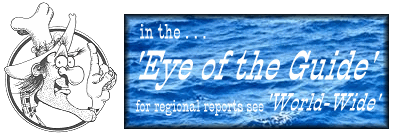The Big Horn River has been at record low
flows for the past two years and it looks
like this year will be no different. At
present, the flow is 1500 cubic feet per
second (cfs). With the drought stretching
into seven years, the outlook isn't too
shining: the Wind River drainage has a snow
pack that is 100 percent of average-good news!
But the Shoshone River drainage is at 60 percent
of normal. (The Wind River drainage supplies more
water to the Big Horn River than the Shoshone,
but it can't make up that much shortfall).
Okay, so what does that mean to you? It means
that the flows will probably be maintained at
1500 cfs-normal minimum flow is 2500cfs. Less
flow results in fewer trout per mile of river
- about 1600 per mile - while the average size
of the trout has increased from 14 to 18 inches
and the condition of the fish is phenomenal
(football shape).

With decreased flows over the past five years
has come a shift of the aquatic invertebrate
population: the main food items in the river
are scuds, sowbugs, midge larvae and pupae,
aquatic worms, and black caddis. The blue-winged
olive (Baetis) hatch remains good and has been
occurring from late April to early June. The pale
morning dun hatch has been sparse, as has the
Trico hatch while the yellow Sally hatch has been
non-existent. Black caddis have been thick as per
usual. The midge hatches have been unbelievably
thick: some days in April, May, and June the
afternoon scene can resemble a living carpet
of insects. A hatch that hadn't occurred prior
to the prolonged drought, the mahogany dun, is
something to witness. The late August/early
September spinner fall of size 12 dark brown
mayflies puts all the trout in the river on a
feeding frenzy. To top it off, the spinner fall
can last up to five hours. So many insects are
on the water that the trout can't eat them all
so feeding goes on the backwaters and eddies up
until dark.
Another change in the river is that baitfish
have become more common, hence the brown trout
are more prone to take streamer flies about
any time during the year. Though the browns
are now the minority trout species in the river,
the ones that remain are substantial fish! (As
per usual, the rainbow trout are fat, full of
energy, and ready to show you how much backing
your reel holds).
Through efforts of the Bighorn River Alliance,
there will be a flushing flow early this March.
It looks like the Bureau of Reclamation will
release 5,000 cfs for eight hours to clean out
much of the accumulated silt in the upper 13
miles of the river.
Speaking of flushing flows, the North Platte
River upstream from Casper, Wyoming has been
receiving spring and fall flushing flows for
a number of years now. The river has become a
great trout fishing stream, much like the Big
Horn. In addition, there is an abundance of
pronghorn antelope and mule deer along the
river-extremely rare sights on the Big Horn. The
stretch of the Platte below Grey Reef has three
species of trout: rainbow, cutthroat (Snake River),
and brown. Many of the trout exceed 20 inches.
Nymphs, streamers, and dry flies are the three
most productive methods. For further information
contact The Platte River Fly Shop (307-237-5997)
or visit the website www.wyomingflyfishing.com.
I guide for the shop now and then. I find that
the shop's competent local guides know every
trout in the river by name.
As per usual, I offer trips on small streams
around Sheridan. We can fish some of the small
streams in the Big Horn Mountains, the Tongue
River in Montana, or the Little Big Horn River
in Wyoming. Going to a different stream for a
day helps anglers to enjoy the best of both
worlds.
A real plus for this year is that I will be
able to offer you a unique two day fishing
experience on the Tongue River in Montana.
The Lodge at Diamond Cross Ranch is about ten
miles downstream from the Tongue River Dam.
The first three or four miles of water below
the dam contain some superlative trout water.
(I have caught 22-inch rainbows with 13-inch
girths in this stretch). Further downstream
the river is loaded with smallmouth bass. We
could fish for trout the first day, stay at the
lodge that night and float for smallmouth the
second day. To check out the lodge,
surf to www.thelodgeatdiamondcross.com or you
can call the manager, Dick Hosford, at 406-757-2220
and he'll be glad to tell you more about the
great recreational opportunities and fine
facilities that he offers.
My son, Glint, still works with me. Few others
exceed his guiding expertise and his humor is
unequalled. Any day spent with Clint is bound
to be enjoyable and memorable.
My rates for this year are $275.00 for a single
angler for one day; $350.00 for 2 anglers; and
$500.00 for three anglers. If you elect to fish
three or more days, the three-day price would be
$750.00; $1000.00 and $1450.00, respectively.
Well, I look forward to hearing from you and hope
that you will honor me with your presence this year.
Take care and stay well. ~ Bob Krumm
About Bob:
Our congratulations to Bob and Carol on their
marriage this past December. Best wishes for
a long and happy life together!
Bob Krumm is a first-class guide who specializes
in fishing the Big Horn River in Montana,
(and if there terrific fishing somewhere else
he'll know about that too.) Bob has written
several other fine articles for the Eye Of The
Guides series. He is also a commericial fly
tier who owns the
Blue Quill Fly Company which will even do
your custom tying! Bob is a long time Sponsor
here! You can reach him at: 1-307-673-1505 or by email at:
rkrumm@fiberpipe.net
|



